Low Glycemic Foods for Diabetics – 6 Diet Tips for Controlling Your Diabetes
| Author: Manoja Kalakanti
Anyone with diabetes knows that they have to keep it in control. They can’t just do or eat whatever they want as it can lead to severe medical complications. And controlling diabetes usually means keeping your blood sugar levels in check. So, people with diabetes need to manage their blood sugar levels to survive.
There are several measures to treat this condition, and eating low glycemic foods for diabetics is one of them. A healthy diet is capable enough of controlling this chronic disease. Medical professionals also recommend several other precautions like maintaining your stress levels, doing more exercises, and following a diet rich in protein and fiber.
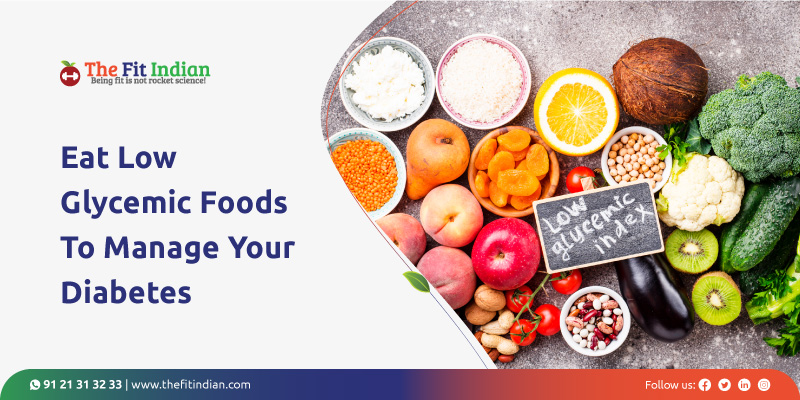
But according to experts, planning your diet is the most effective tool for keeping diabetes in control. You can also monitor how each food reacts with your body, especially your blood sugar levels. And eating low glycemic foods is your best bet at regulating blood sugar and keeping diabetes on a
But what exactly are low GI foods? And how are they different?
All You Need to Know About Glycemic Index – The Importance of Low Glycemic Foods for Diabetics
Unlike other foods, one main quality of low glycemic foods is that they are digested slowly in the body. When the digestion process is slow, the rise in sugar levels in the body is also moderate. This regulation of sugar levels helps in controlling diabetes.
Low Glycemic Foods
Low glycemic foods mainly contain carbohydrates, and they are based on the concept of Glycemic index or GI. Low glycemic foods, once eaten, are digested and absorbed into the body slowly. Therefore, their effect on blood sugar levels is moderate. This means foods with low GI carbohydrates raise your blood sugar slowly. On the other hand, foods with high GI have a strong impact on sugar-level by raising them rapidly, which is not good news for people with diabetes.
You’re probably getting confused with the term GI or Glycemic Index. Well, let’s talk about it.
What is Glycemic Index (GI)?
It is a system that ranks different foods from 1 to 100 based on how quickly they raise the blood sugar/glucose levels. These values tell us which foods raise glucose levels slowly and which ones raise them quickly.
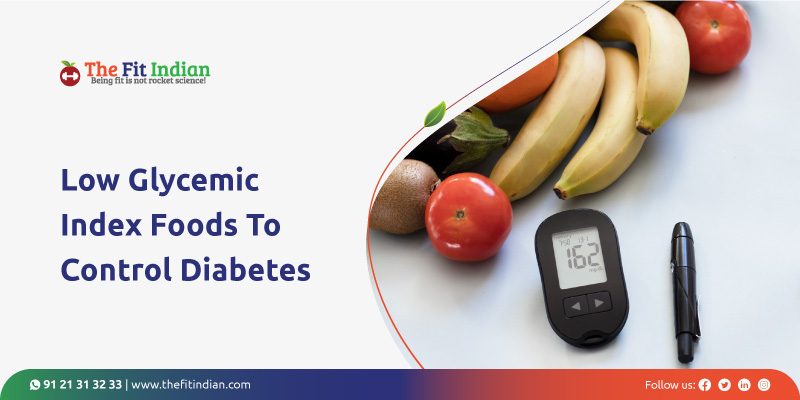
Foods with a low GI are generally digested and metabolized at a slow pace, while high GI foods are absorbed way faster.
Here’s the different range of GI values:
- Low GI value: 1 – 55
- Medium GI value: 55 – 70
- High GI value: 70+
This means that these low GI carbohydrates-containing foods can help manage diabetes by carefully regulating your glucose levels. But how does that work?
Let’s talk briefly about using low glycemic foods for diabetes management.
How Low GI Foods Can Manage Diabetes
Low GI foods control your blood sugar levels, which will manage your diabetes. But diabetes is a complicated and fatal disease. Millions of people suffer from it, and many have even died from this condition. So, just eating a bunch of healthy foods is not enough. So, how do low GI carbohydrates help manage diabetes?
To know that, let’s go into some scientific background inside our bodies.
All you Need to Know About Diabetes and Blood Sugar Level
Among many hormones in our body, diabetes affects one hormone called insulin. Insulin plays a crucial part in the digestion of any food. During the digestion process, the insulin hormone separates the glucose generated from the food and transfers it to the cells in your body. And the cells use this glucose as an energy source to perform their functions. Glucose acts as fuel to these cells. But diabetes interferes with this process.
This disease prevents insulin from taking the sugar to the cells, so they get leaked into the bloodstream. And if this happens consistently, it will damage your blood vessels and lead to primary organ failures like nerve damage, heart disease, strokes, and kidney diseases.

This is why maintaining sugar levels is vital if you already have diabetes. This is possible by controlling your diet because certain foods raise your blood sugar levels higher and faster, while others only do that at a moderate pace. So, understand which foods (low GI) can help you. And there is one more thing. What role do carbohydrates play in affecting diabetes?
Effects of Carbohydrates on Diabetes Management
Also called carbs, carbohydrates are a type of nutrient. When you eat something with carbs, the food is digested and absorbed into a sugar called glucose. And that glucose will be passed down to cells as an energy resource. And you just learned what happens if you have diabetes. Sugar will directly get released into the blood, increasing glucose levels.
Not every carb-food raises your sugar levels. According to studies, low GI foods can lower the blood glucose levels of people with diabetes. Now, you know what low glycemic foods and their effect on people with diabetes are. We can say for a fact that low GI foods are good for you.
What should you do now? In order, there are three main things you need to manage your diabetes.
- First, learn what factors and old food habits can affect your blood sugar levels and what you can do to regulate it.
- Second, you need to know the GI values of different foods you eat every day.
- Third, you need to have a daily low glycemic diet plan to start keeping up with diabetics.
Six Expert Diet Tips on only Eating Low GI foods
Since diabetic patients are only allowed to consume certain foods that have “low GI,” we need to understand how specifically the GI value is determined for foods and learn how to keep that value at a low level, so you can keep eating low GI foods for managing diabetes.
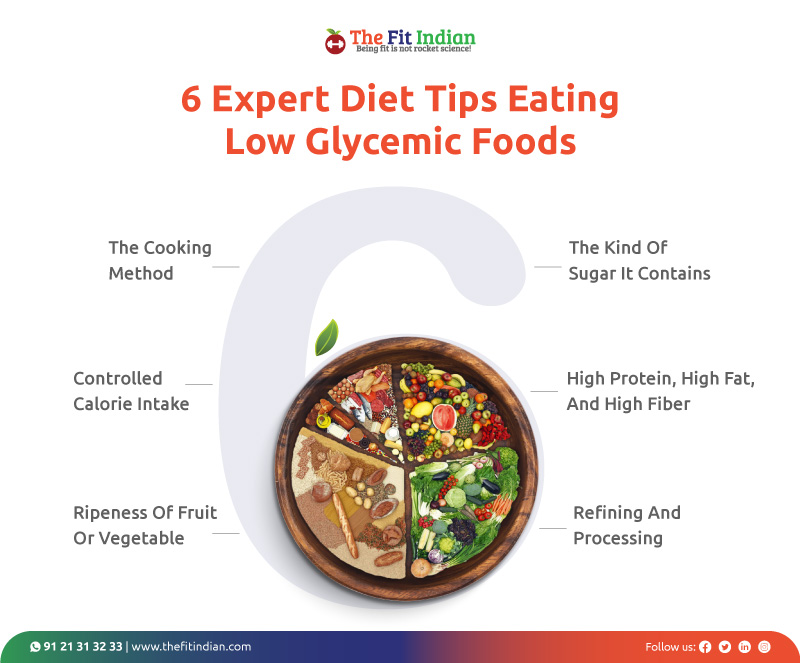
These are the six main factors you need to keep in mind.
1. The cooking method
Not just the food itself but the way you cook can affect the glycemic index. Certain low GI carb foods might turn into high GI when you cook them too long. Meaning – the cooking process of food can increase the GI value. For example, everybody knows deep-frying is an unhealthy way of cooking, and yes, it does increase the GI.
What should you do:
Don’t cook for too long. When you cook anything for longer periods, the food will be digested quicker, thus raising the glucose levels. Boiling food is much better than frying it. Frying usually takes longer and kills the nutrients in the food.
2. Controlled calorie intake
Don’t eat too much. When you are eating a lot, you will consume more calories and carbohydrates. Even low GI foods are good for you, but doing it too much will incrementally add up, creating an overall high GI value in the body. Overeating can lead to other diabetes-related problems like obesity. Obesity is one of the biggest causes of type-2 diabetes. Having diabetes and also being obese is the quickest way to fatality.
What you should do:
Eat less and keep an eye on your calorie intake. Control your portions by consuming fewer low GI carbohydrates in every meal. Always keeping your calories in check is a great habit nonetheless.
3. Ripeness of fruit or vegetable
How does that work? In the beginning stage, unripe fruits or vegetables contain carbohydrates that dissolve into multiple sugars as the fruit ages. As the fruit ripens, its GI value gets higher along with it.
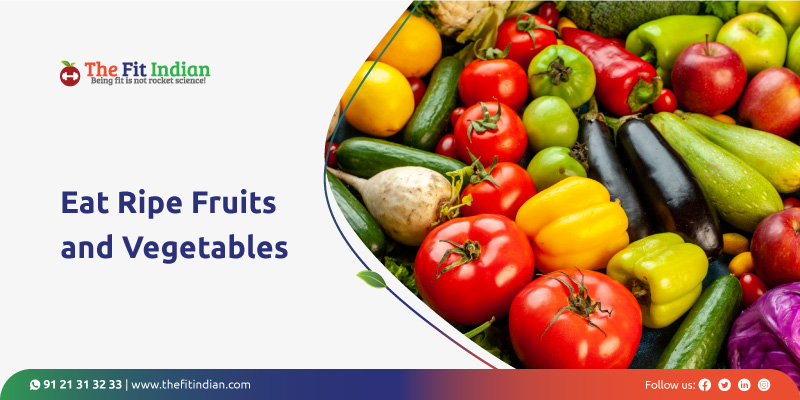
For example, a soft banana has a high GI of 50, while a ripe one scores below 30. So, when you eat a high ripened fruit, you take multiple sugars in, increasing the glucose levels in your body. The same applies to ripened vegetables.
What should you do:
Only eat fresh low GI fruits and low GI vegetables. When shopping for groceries, make sure to check if the vegetable is ripe or unripe. You don’t eat everything right away, so they need to turn ripe later when you finally eat it. Suppose you took an apple out of the refrigerator, but it’s a little soft. You can’t afford to be lazy with diet when you have diabetes.
4. The kind of sugar it contains
As we already know, high blood sugar levels mean high glucose. So, foods with elevated sugar content will have a high rank in GI because the sugar closely relates to glucose. You take in glucose, the body’s glucose level increases.
But that’s not it. Not all sugar is bad. Some sugar substitutes have a low GI, like fructose. While maltose, another substitute, ranks at a whopping 105. So, the food’s GI also depends on the kind of sugar it contains.
What should you do:
Consuming sugar is unhealthy for any individual. The easy way is to eat foods that have low sugar content. You can try some sugary foods with a low glycemic index, like sweet potatoes, apples, bananas, and mangoes. You can eat chocolate chip cookies, lemon cakes, cinnamon rolls, and smoothies made with certain powders.
5. High protein, high fat, and high fiber
When the food is digested and absorbed faster, the blood sugar increases quickly. Low glycemic carb foods control the blood sugar level by slowly digesting the food.
Another way for moderate digestion is by adding low GI protein, fat, or fiber to your meals. All three of these components can perform a similar function. The fat or protein content in the food needs extra time to digest, thus making the whole digestion process longer. And that is good for anyone with diabetes.
What should you do:
You might think fat-oriented foods are not good for diabetes, but several healthy fats can actually lower your GI. So, prefer eating low GI protein, fat, and fiber-oriented foods because foods loaded with extra nutrients help maintain your sugar levels. In every meal you eat, make sure there is a good amount of fiber, protein, or both.
6. Refining and Processing
In general, ‘processing’ the foods makes them less healthy and significantly increases the GI levels. Refining processes like grinding, rolling, mixing can disturb molecules like amylose and amylopectin, and that raises the GI.
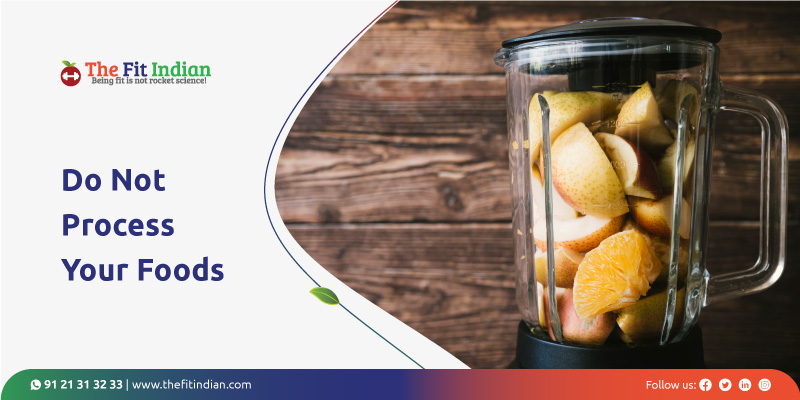
Processed foods will get digested faster, increasing glucose levels. Simply put, if the food is processed more, it will become a high glycemic food.
What should you do:
Don’t process your foods. You generally process foods like mixing and juicing your fruits, baking cakes in the oven, and drinks with added processed sugar in any home. We already know people with diabetes can’t consume cakes and sugars.
And don’t eat pre-processed foods. Processed foods range from frozen Rotis to fast-food noodles to chips. You might think that buying high-branded parathas and heating them is healthy. False! No matter how healthy a meal seems, it will have a high GI value when put in a packet and freeze it. And you shouldn’t eat processed junk and fast foods even if you have or don’t have diabetes.
You need to know the GI values of all the foods you generally eat at home. So that you realize which ones have a low GI that is good for you and the high GI foods that you need to stop eating.
Got any idea what to eat? Apples or bananas? And you are not supposed to eat white rice because of its high GI value. What else is there to eat then?
Here’s the list of common foods divided by their GI values.
List of Low GI, Medium GI and High GI foods:
In the table below, you can see the foods are separated between low GI foods and medium and high GI foods. You might be surprised to see watermelons and potatoes have a very high GI score. So, save this table and re-evaluate the foods that you may have to avoid.
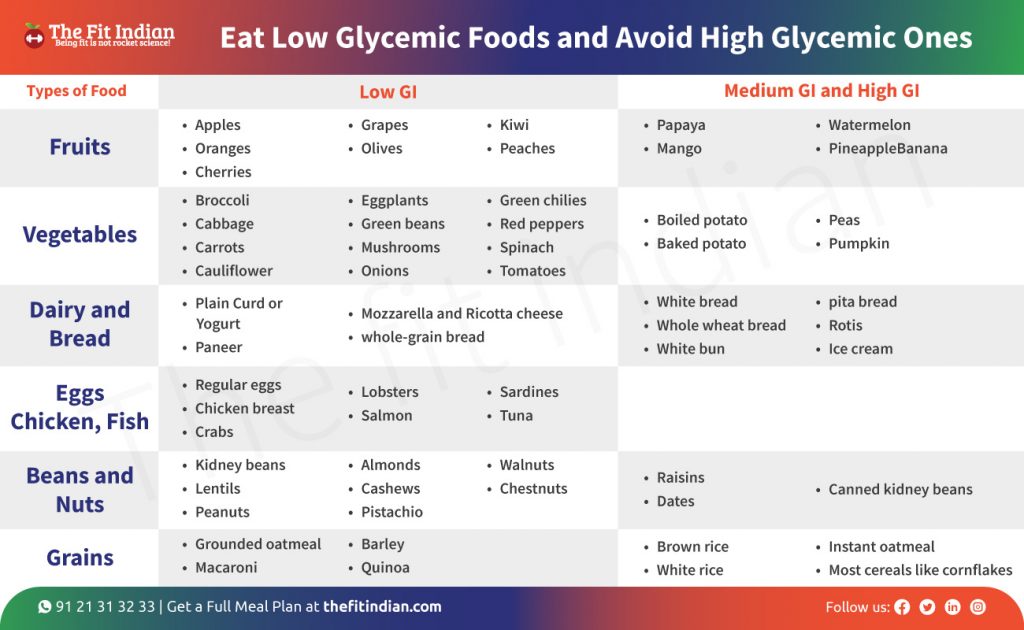
By just eating the mentioned low GI foods will significantly improve your health and help you easily manage your condition.
Note: There is no rule that says you must avoid high GI foods altogether. You can still eat them by combining them with low GI foods. Just make sure not to eat them too often.
To implement these low GI foods in your life, we are giving a bunch of carefully planned meals with low glycemic Indian foods for each time of the day.
Here’s the detailed low GI diet plan for breakfast, lunch, dinner meals, and snacks. I’m also giving different combinations of meals, so you don’t have to eat the same things every time.
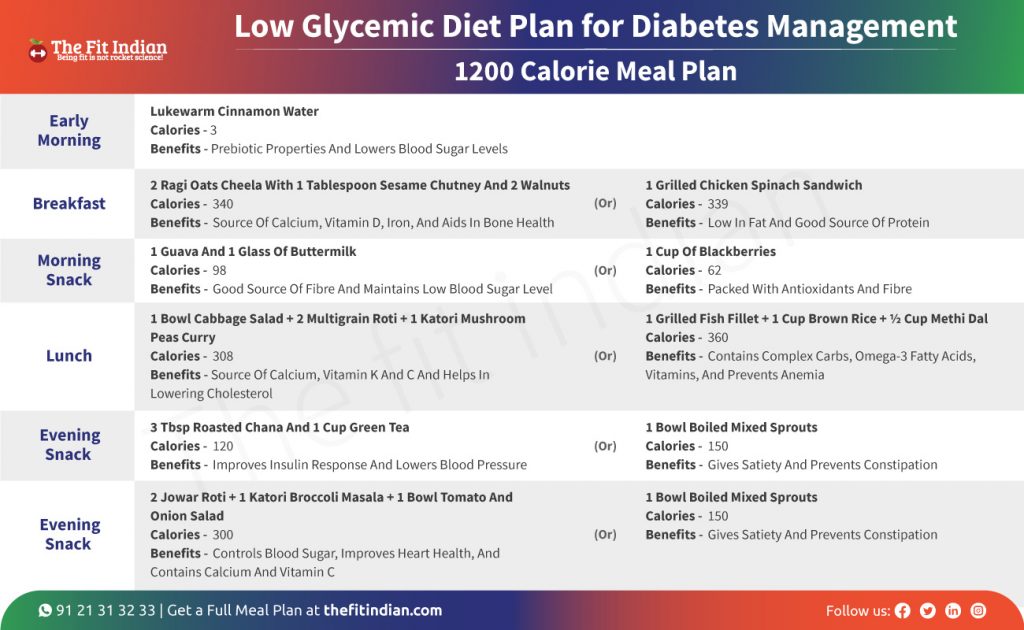
This is all the guidance and planning needed for managing your diabetes. Re-evaluate your current eating habits and start incorporating low glycemic foods into your diet. Let me leave you with this.
Takeaway
If you can implement at least some of the expert tips and properly follow this low glycemic diet plan, you will have the power to control diabetes. Not just that, low GI foods can help in lowering the risk of other potential diseases. Diabetes or not, it is important to maintain a balanced diet consuming a variety of foods based on their GI.
FAQ’s
1. What is the glycemic index?
Glycemic index (GI) is a ranking system that divides different foods from 1 to 100 based on how quickly they raise the blood sugar levels. If the food has a low GI, it is digested slowly, and the sugar level is also raised at a moderate pace. But, foods with high GI make rapid changes to your glucose levels.
2. What are low glycemic carbs?
Low glycemic carbs are foods with carbohydrates that have a low glycemic index or GI. Foods with a low GI are digested in the body at a steady pace. When digestion is slow, the change in glucose levels is also low. Ultimately, keeping your body’s sugar levels in control.
3. What are low glycemic foods?
Low glycemic foods are based on the concept of Glycemic index or GI. Low glycemic means they have a low GI. These foods are digested slowly. Which means the blood sugar level is raised at a steady pace. And that is why people with diabetes eat low glycemic foods to maintain their blood sugar.
4. What foods should I eat to lower my glycemic level?
Here are some common foods to lower your glycemic level:
Apples, oranges, carrots, cauliflower, eggplants, onions, tomatoes, curd, paneer, egg whites, chicken breast, and crabs.
5. Can low glycemic foods help with weight loss?
To put it simply, low glycemic foods are some of the healthiest options out there, so yes, they can aid you in losing some weight or just in maintaining it. The best way to lose weight is through regular exercise and a low-calorie healthy diet.
6. What foods are not included in the glycemic index?
Glycemic index or GI is a measure of how foods that contain carbohydrates affect blood sugar levels. Any food that doesn’t have carbs is not included in the GI. So, foods like meat, butter, water, and some types of fish are not included in this index.
7. Do low glycemic index diets work?
This diet is made for people who need to keep their diabetes in control. In a low glycemic diet plan, you can generally include foods with a low glycemic index or GI because low GI food releases glucose slowly during the digestion process. Due to that, sugar levels in the body are always in control.
8. Why is it important to eat a low glycemic diet?
People with diabetes need to keep the condition in control. And planning your diet is the most effective way to manage diabetes. The best diet for a person with diabetes is eating low glycemic foods to regulate your blood sugar levels.
9. What is the purpose of the glycemic index?
The purpose of glycemic index or GI is to separate foods based on how they affect your body’s glucose levels. Foods labeled as high GI raises your glucose levels at a rapid rate, increasing your blood sugar. And the foods with low GI raise your glucose level at a slow stride.
10. What foods can I eat on a low GI diet?
Here are some low GI foods for your diet:
Low GI Fruits: Apples, Oranges, Cherries, Grapes
Low GI Vegetables: Cabbage, Carrots, Cauliflower, Eggplants, Green beans, Mushrooms, Onions, and Tomatoes.
Other common foods: Plain curd, paneer, whole grain bread, egg whites, chicken breast, crabs, sardines, and salmon




Manoja Kalakanti